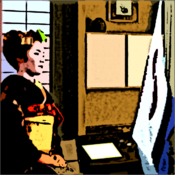Shurigawa under Beiwanese rule
 | |||||||||
| Capital | Okinokyo | ||||||||
| Official languages | Japanese | ||||||||
| Government | Beiwanese Dependent Territory | ||||||||
• Emperor | Liu-kuang | ||||||||
• Governor | Robert Zhang | ||||||||
| Currency | Won | ||||||||
| |||||||||
From 9 September to 22 September 2014, Shurigawa was a Beiwanese Dependent Territory.
History
History of Gajajima and Kogajajima
Per local folklore, the island was one of the havens of the defeated Heike clan after they lost the Gempei War against the Minamoto clan. It came under the control of the Shimazu clan from 1434. During the Edo period, Takarajima was part of Satsuma Domain and was administered as part of Kawabe District. In 1896, the island was transferred to the administrative control of Ōshima District, Kagoshima, and from 1911 was part of the village of Toshima, Kagoshima. A lighthouse was completed in 1940, and the population at that time was 133. The village had an elementary school, and its own ship for connection to the mainland and other islands. From 1946-1952, the island was administered by the United States as part of the Provisional Government of Northern Ryukyu Islands. A junior high school was built in 1948, power plant and water treatment plant in 1961 and telephone system in 1966. The population was economically supported by commercial fishing for bonito. However, the island was repeated devastated by typhoons, especially in 1945, 1951, 1956, and 1957 leading to plans to relocate the population to either Amami Oshima or mainland Kagoshima Prefecture. Collapse of the bonito fisheries for unknown reasons financially ruined the islanders and led to near famine conditions, causing many islanders to leave. A decision was reached by the government to relocate the remaining seven households with a total of 28 people to Kagoshima on January 1970. At the time of the evacuation on 28 July 1970, only 4 households with 16 people were remaining. However, even after the evacuation of the inhabitants, the lighthouse remained manned until April 1982. Although landing is not permitted to the general public, the abandoned buildings have been looted, and in 1996 the Japanese government discovered that a party of six Chinese had illegally landed on the island and were attempting to establish residence. Groups of former island residents have visited the island in 2001 and 2010 to take care of their ancestral graves. Kogajajima does not appear to have ever had permanent human habitation. During the Edo period, Kogajajima was part of Satsuma Domain and was administered as part of Kawabe District. In 1896, the island was transferred to the administrative control of Ōshima District, Kagoshima, and from 1911 was administered as part of the village of Toshima, Kagoshima. From 1946-1952, the island was administered by the United States as part of the Provisional Government of Northern Ryukyu Islands.
Shikaeshi War
The Shikaeshi War was a conflict fought primarily between the Imperial State of Shurigawa with the Fascist Republic of Okinoshima and the Greater Beiwanese Empire from 26 August 2014. Beiwan fought Shurigawa with help from the Principality of Lomellina and Republic of Koya. The Shikaeshi War was the largest micronational East Asian war in the 21st century. The war was the result of the Imperialist Beiwanese policy aiming to dominate Shurigawa politically and militarily.

On 6 July 2014, Shurigawan Empress Yukie ordered to surrender to the Imperial Beiwanese Military. Two days later, Empress Yukie was forced to abdicate but she was allowed to live in the Imperial Castle. By order of the Beiwanese Emperor, the Imperial Castle of Shurigawa was forbidden for Beiwanese troops to enter. Shurigawa was ceded to the Greater Beiwanese Empire as the Occupation of Shurigawa.
Occupation of Shurigawa
At the near end of Shikaeshi War, Shurigawa was led by Robert Zhang, the Supreme Commander, with support from the Republic of Koya and Principality of Lomellina. It transformed the country into a dictatorship that recalled Beiwanese "authoritarian-personalist" politics. When Beiwan become communist The Imperial State of Shinmyo annexed Shurigawa.

